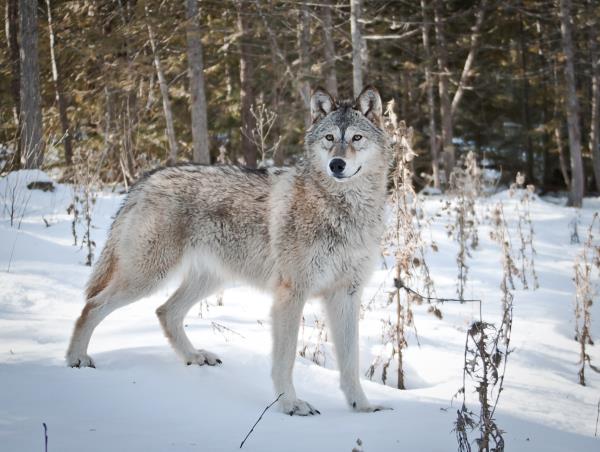Wolf population estimated for first time in four years
 BOISE – Idaho Department of Fish and Game has released an Idaho wolf population estimate for the first time in four years and it’s much higher than the last estimate.
BOISE – Idaho Department of Fish and Game has released an Idaho wolf population estimate for the first time in four years and it’s much higher than the last estimate.
But IDFG and other wolf management officials cautioned against making hard comparisons between the 2015 and 2019 estimates because they were arrived at using different methods and calculations.
During an Idaho Fish and Game Commission meeting Jan. 23, IDFG staff estimated there were a peak total of 1,541 wolves in Idaho during the summer of 2019.
That number has since been reduced to about 1,000 because of the number of wolves taken by hunters, trappers, through management actions to eliminate problem wolves and those that died by natural causes.
But that’s still much higher than the 2015 estimated of 786 Idaho wolves that was reported in early 2016.
According to an IDFG news release, “Biologists cautioned that comparing the 2015 estimate of 786 … to the current estimate would be misleading because previous estimates were based on different methods and represented winter counts when the population was closer to its lowest point of the year.”
When the 2015 estimate took place, “We knew that was a minimum that we could scientifically prove were out there,” said IDFG spokesman Roger Phillips. “We knew there were more.”
When the fish and game department’s wolf monitoring program was under federal oversight from 2006 to 2015, the department used radio collars to calculate wolf numbers.
Annual wolf estimates stopped after the 2015 count.
Last year, IDFG deployed 569 cameras around the state specifically for the purpose of estimating Idaho’s wolf population. Those cameras took 11 million photos over the course of a few months last summer.
Of those 569 cameras, 259 detected wolves, according to the IDFG news release.
Using recognition software to rapidly determine photos of animals, wildlife technicians identified species of animals in the photos and biologists and university scientists applied mathematical modeling to produce the wolf population estimate, according to the news release.
“The method of estimating wildlife populations using remote cameras is a new innovation,” the IDFG news release states. “As time goes on, the modeling will continue to be refined as biologists use this technique to generate annual population estimates. Going forward, they will also have a better baseline for comparing populations from year to year.”
Todd Grimm, the Idaho Director of Wildlife Services, a federal agency that helps solve conflicts between humans and animals, also cautioned against reading too much into the difference between the estimates.
“I don’t know that [the 2019 estimate] really says anything just because of the fact the methods used to come up with that number are different than the methods that they used to get the previous estimates from,” he said. “So it’s not apples to apples.”
But, he added, now that the fish and game department will use the same methods annually, “It will be interesting to see where it goes from here on out.”
Gov. Brad Little’s recommended fiscal year 2021 budget includes $408,000 in dedicated and federal funds “to conduct enhanced research on wolf populations and evaluate methods to effectively manage them.”
Phillips said the IDFG had to pull funds from other sources within the department last year to pay for a lot of the camera monitoring. The $408,000 sought for the next fiscal year will be used specifically to continue that monitoring program, he said.
During a meeting of the Idaho Wolf Depredation Control Board last August, IDFG Director Ed Schriever spoke about the effort to install cameras around the state to monitor wolves.
He said the camera network will allow the department to make reliable annual wolf estimates.
“We believe we have a responsibility to communicate to the public how many (wolves) we have, where they are and their management,” he said.
Still can't find what you are looking for? Find by topic:
- Achievement Award (YF&R)
- Actions Alerts
- Advocacy
- Ag Ambassadors
- American Farm Bureau
- American Farm Bureau Policy Book
- Archive Photos
- Articles
- Board of Directors
- Calendar - State/District
- Calendar - County
- Capitol Reflections
- Collegiate Chapters
- Committee Application Form
- Commodities
- Convention Annual
- County Presidents & Board Information
- County Resource Page
- Delegate Form
- Discount Programs
- Discussion Meet
- Discussion Meet - High School
- Education Programs
- Events
- Excellence Award (YF&R)
- Expense Voucher
- Flickr
- Gem State Producer
- High School Discussion Meet
- High School Speech Contest
- Hope in Idaho Ag
- House of Delegates Credentials Form
- IFBF Board of Directors
- IFBF Policy Book
- IFBF Staff
- Insurance
- Legislative Action Program
- Legislative Issues
- Library
- MAC Trailer
- Magazines
- Map My Benefits
- Member Benefits
- Member Discount
- Membership Application
- Mission Statement
- Moving Agriculture to the Classroom
- Newsletter Sign up
- News Releases
- News Room
- Open Range Law
